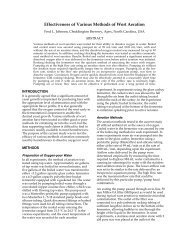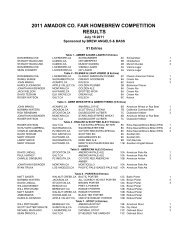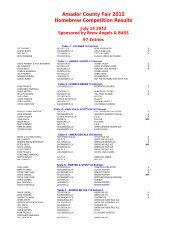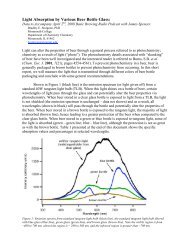A Homebrewer's Guide to Beer Flavor Descriptors - Brew Angels
A Homebrewer's Guide to Beer Flavor Descriptors - Brew Angels
A Homebrewer's Guide to Beer Flavor Descriptors - Brew Angels
You also want an ePaper? Increase the reach of your titles
YUMPU automatically turns print PDFs into web optimized ePapers that Google loves.
oxidation, or a fresh, raw vegetable character<br />
which is a pleasant flavor attributed <strong>to</strong> hops.<br />
Cooked vegetable flavor is caused by sulfurcontaining<br />
compounds. It is primarily perceived<br />
by aroma and <strong>to</strong> a lesser extent by taste.<br />
In his comprehensive review of the threshold<br />
of flavor components of beer, M. Meilgaard identified<br />
three compounds that cause a cooked vegetable<br />
flavor. These compounds and their threshold<br />
value in beer are diethyl sulfide, 1.2 ppb;<br />
dimethyl sulfide, 50 ppb; di‐isopropyl sulfide, 20<br />
ppb.<br />
It is important <strong>to</strong> point out that the threshold<br />
values of these compounds are very low, indicating<br />
that the presence of only a very small amount<br />
would cause a flavor effect.<br />
A primary source of cooked vegetable flavor is<br />
the malt or malt extract used in brewing. Variations<br />
in the malting process may enhance the development<br />
of this flavor. Homebrewers who are<br />
experiencing difficulty with this cooked vegetable<br />
flavor may find the simplest method of corrective<br />
action is simply <strong>to</strong> use a high‐quality brand of<br />
extract. If the flavor persists, brewing process<br />
modifications may be necessary. A longer wort boil<br />
may eliminate the sulfur compounds by volatilization.<br />
Bacteria may also produce sulfur compounds<br />
responsible for cooked vegetable favor. Wort infection<br />
may be a source of such bacteria. Bacterial<br />
contamination in yeast is another source. The<br />
practice of using yeast several times may introduce<br />
bacteria and cause eventual flavor degradation.<br />
Using a pure yeast strain and brewing practices<br />
that ensure sterility are useful steps <strong>to</strong> eliminate<br />
the development of cooked vegetable flavor in<br />
beer.<br />
Diacetyl<br />
By Norman Soine<br />
Diacetyl, one of a class of organic compounds<br />
known as vicinal dike<strong>to</strong>nes, is an essential flavor<br />
component of beer. Most tasters can detect levels<br />
in excess of 0.15 ppm in most types of products, but<br />
it can be recognized as low as 0.05 ppm in delicately<br />
flavored pale lagers where its presence is unmasked<br />
by the absence of highly flavored components<br />
such as melanoidins.<br />
Diacetyl is recognized by a butter <strong>to</strong> butterscotch<br />
flavor often accompanied by a sensation of<br />
“sIickness” on the palate. Although opinion varies,<br />
most people agree that low levels (0.1 ppm or less)<br />
contribute <strong>to</strong> a fullness of character in the beer.<br />
Diacetyl in beers can be generated in two<br />
ways: by yeast, as a normal fermentation byproduct,<br />
and by beer‐spoilage bacterial infection.<br />
Yeast produces diacetyl from sugars via pyruvate<br />
and ace<strong>to</strong>lactate metabolic formations.<br />
Diacetyl is produced in large quantities, often exceeding<br />
0.5 ppm, during the early stages of fermentation.<br />
As the fermentation progresses, the yeast<br />
assimilates the diacetyl, converting it metabolically<br />
<strong>to</strong> ace<strong>to</strong>in and finally 2,3,butanediol, a compound<br />
with a high flavor threshold.<br />
Fermentation conditions that influence diacetyl<br />
production and reduction by yeast include yeast<br />
strain, wort compositions, and most importantly,<br />
temperature, s<strong>to</strong>rage time and amount of yeast in<br />
suspension.<br />
Extended warmer temperatures during fermentations<br />
tend <strong>to</strong> reduce diacetyl. Ales, being<br />
fermented at elevated temperatures, are less apt<br />
<strong>to</strong> be affected by yeast‐produced diacetyl.<br />
Worts with high adjunct ratios of sugar,<br />
unmalted grains, grits, starches, etc., tend <strong>to</strong> produce<br />
higher diacetyl Ievels.<br />
The genetically inherited flocculation characteristics<br />
of yeast strains and the influence of wort<br />
constituents (such as calcium magnesium and<br />
sodium ion concentrations, presence of active, fermentable<br />
sugar‐generating enzymes, available<br />
nitrogen levels) as they affect the flocculation<br />
characteristics can also affect diacetyl removal.<br />
SPECIAL ISSUE 1987 ZYMURGY 38






